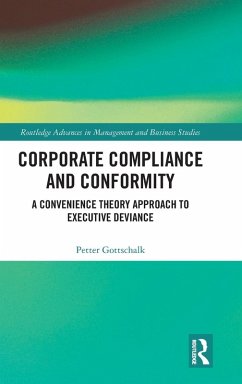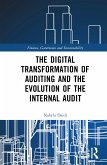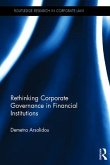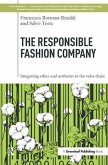Petter Gottschalk
Corporate Compliance and Conformity
A Convenience Theory Approach to Executive Deviance
Petter Gottschalk
Corporate Compliance and Conformity
A Convenience Theory Approach to Executive Deviance
- Gebundenes Buch
- Merkliste
- Auf die Merkliste
- Bewerten Bewerten
- Teilen
- Produkt teilen
- Produkterinnerung
- Produkterinnerung
This book takes a new approach by turning the problem of control upside down as it focuses on control of executives who find white-collar crime convenient. The bottom-up approach to executive compliance focuses on organizational measures to make white-collar crime less convenient for potential offenders.
Andere Kunden interessierten sich auch für
![Fraud Investigation Fraud Investigation]() Petter GottschalkFraud Investigation197,99 €
Petter GottschalkFraud Investigation197,99 €![Strategic Security Strategic Security]() Jean PeroisStrategic Security163,99 €
Jean PeroisStrategic Security163,99 €![Islamic Macroeconomics Islamic Macroeconomics]() Raja AlmarzoqiIslamic Macroeconomics166,99 €
Raja AlmarzoqiIslamic Macroeconomics166,99 €![The Digital Transformation of Auditing and the Evolution of the Internal Audit The Digital Transformation of Auditing and the Evolution of the Internal Audit]() Nabyla DaidjThe Digital Transformation of Auditing and the Evolution of the Internal Audit174,99 €
Nabyla DaidjThe Digital Transformation of Auditing and the Evolution of the Internal Audit174,99 €![Rethinking Corporate Governance in Financial Institutions Rethinking Corporate Governance in Financial Institutions]() Demetra ArsalidouRethinking Corporate Governance in Financial Institutions143,99 €
Demetra ArsalidouRethinking Corporate Governance in Financial Institutions143,99 €![Casino Security and Gaming Surveillance Casino Security and Gaming Surveillance]() Derk J BossCasino Security and Gaming Surveillance197,99 €
Derk J BossCasino Security and Gaming Surveillance197,99 €![The Responsible Fashion Company The Responsible Fashion Company]() Francesca Romana RinaldiThe Responsible Fashion Company195,99 €
Francesca Romana RinaldiThe Responsible Fashion Company195,99 €-
-
-
This book takes a new approach by turning the problem of control upside down as it focuses on control of executives who find white-collar crime convenient. The bottom-up approach to executive compliance focuses on organizational measures to make white-collar crime less convenient for potential offenders.
Hinweis: Dieser Artikel kann nur an eine deutsche Lieferadresse ausgeliefert werden.
Hinweis: Dieser Artikel kann nur an eine deutsche Lieferadresse ausgeliefert werden.
Produktdetails
- Produktdetails
- Verlag: Taylor & Francis
- Seitenzahl: 236
- Erscheinungstermin: 10. März 2023
- Englisch
- Abmessung: 234mm x 156mm x 16mm
- Gewicht: 522g
- ISBN-13: 9781032459080
- ISBN-10: 1032459085
- Artikelnr.: 66729972
- Herstellerkennzeichnung
- Libri GmbH
- Europaallee 1
- 36244 Bad Hersfeld
- gpsr@libri.de
- Verlag: Taylor & Francis
- Seitenzahl: 236
- Erscheinungstermin: 10. März 2023
- Englisch
- Abmessung: 234mm x 156mm x 16mm
- Gewicht: 522g
- ISBN-13: 9781032459080
- ISBN-10: 1032459085
- Artikelnr.: 66729972
- Herstellerkennzeichnung
- Libri GmbH
- Europaallee 1
- 36244 Bad Hersfeld
- gpsr@libri.de
Petter Gottschalk is Professor in the Department of Leadership and Organizational Behaviour at BI Norwegian Business School in Oslo, Norway. Before joining academics, he held several chief executive officer positions in business enterprises. He received his education in Germany (Technical University of Berlin), United States (Dartmouth College and Massachusetts Institute of Technology), and United Kingdom (Henley Management College). Dr. Gottschalk has published extensively his research on knowledge management, police investigations, fraud examinations, white-collar crime, convenience theory, and corporate investigations.
Introduction
References
PART I CRIME CONVENIENCE
Chapter 1 Compliance-Conformity-Convenience
Compliance in Corporate Governance
Remaking Capitalism for Social Acceptance
Responses to Normative Pressures
Research Perspectives on Compliance
Legalistic and Formalistic Approaches
Compliance Audits and Risk Assessment
Fraud Examinations of Compliance Failures
Maturity Model for Corporate Compliance
References
Chapter 2 Profiling White-Collar Offenders
Structural Convenience Model
Profiling Motive Convenience
Profiling Opportunity Convenience
Profiling Willingness Convenience
Visual Offender Profile Representation
References
Chapter 3 Convenient Corruption in Sports
Characteristics of Sport Corruption
Convenience in Sport Corruption
Corrupt Sport Nations
Corrupt Sport Coaches
Corrupt Biathlon President
Bribers and Bribed Officials
References
Chapter 4 Economic Crime in the Fishing Industry
Structural Model of Convenience
Economic Motive Convenience
Business Opportunity Convenience
Personal Willingness Convenience
IUU Fishing Convenience Propositions
Electronic Reporting for Compliance
References
Chapter 5 Covid-19 Creative Non-Compliance
Variety of Covid-19 Frauds
Covid-19 Fraud Convenience
Convenient Motive during Pandemic
Convenient Opportunity during Pandemic
Convenient Willingness during Pandemic
Magnitude of Crime during Pandemic
References
Chapter 6 Stigma or Competition Effect
Corporate Crises and Scandals
Effects on Non-Accused Firms
Fraud Investigation Reports
Peer Product Market Overlap
References
PART II COMPLIANCE CONTROL
Chapter 7 Corporate Social License to Operate
Characteristics of the Social License
Danish Bestseller in Myanmar
Social Housing by Obos in Norway
Icelandic Samherji Fishing in Namibia
Shortcomings of Legal Perspectives
References
Chapter 8 Bottom-Up Corporate Control
Chief Executive Offenders
Offender Crime Convenience
Offender Status Convenience
Resource Access Convenience
Organization Deterioration Convenience
Role Agency Convenience
Rule Complexity Convenience
Outside-In Approaches
References
Chapter 9 Auditors Disturbing Crime Convenience
Crime Prevention and Detection
Convenience Disturbance Themes
Disturbing Motive Convenience
Disturbing Opportunity Convenience
Disturbing Willingness Convenience
Auditing Practice Disturbance Gap
References
Chapter 10 Theater of the Courtroom
Member of Parliament and Mansion Architect
Storytelling in the Courtroom Theater
Embezzlement by Member of Parliament
Corruption by Summer Mansion Architect
Language Games in Prosecution and Defense
Questioning by Prosecution and Defense
References
Chapter 11 Corporate Internal Investigations
Australian, Dutch, and UK Research
Secrecy of Investigation Reports
Review of 163 Investigation Reports
Outcomes for Crime Suspects
References
Appendix A Characteristics at Suspicion
Appendix B Characteristics of Suspects in Norway
Appendix C Characteristics of Other Suspects
Appendix D Comparison of Outcomes for Suspects
Chapter 12 Characteristics of Corporate Investigators
Alternative Policing of Economic Crime
Australia: Professional Image
Canada: Role of Private Sector
The Netherlands: Professional Roles
Norway: Outcome of Investigations
The United Kingdom: Second Careers
Evaluation of Investigation Reports
References
Conclusion
References
PART I CRIME CONVENIENCE
Chapter 1 Compliance-Conformity-Convenience
Compliance in Corporate Governance
Remaking Capitalism for Social Acceptance
Responses to Normative Pressures
Research Perspectives on Compliance
Legalistic and Formalistic Approaches
Compliance Audits and Risk Assessment
Fraud Examinations of Compliance Failures
Maturity Model for Corporate Compliance
References
Chapter 2 Profiling White-Collar Offenders
Structural Convenience Model
Profiling Motive Convenience
Profiling Opportunity Convenience
Profiling Willingness Convenience
Visual Offender Profile Representation
References
Chapter 3 Convenient Corruption in Sports
Characteristics of Sport Corruption
Convenience in Sport Corruption
Corrupt Sport Nations
Corrupt Sport Coaches
Corrupt Biathlon President
Bribers and Bribed Officials
References
Chapter 4 Economic Crime in the Fishing Industry
Structural Model of Convenience
Economic Motive Convenience
Business Opportunity Convenience
Personal Willingness Convenience
IUU Fishing Convenience Propositions
Electronic Reporting for Compliance
References
Chapter 5 Covid-19 Creative Non-Compliance
Variety of Covid-19 Frauds
Covid-19 Fraud Convenience
Convenient Motive during Pandemic
Convenient Opportunity during Pandemic
Convenient Willingness during Pandemic
Magnitude of Crime during Pandemic
References
Chapter 6 Stigma or Competition Effect
Corporate Crises and Scandals
Effects on Non-Accused Firms
Fraud Investigation Reports
Peer Product Market Overlap
References
PART II COMPLIANCE CONTROL
Chapter 7 Corporate Social License to Operate
Characteristics of the Social License
Danish Bestseller in Myanmar
Social Housing by Obos in Norway
Icelandic Samherji Fishing in Namibia
Shortcomings of Legal Perspectives
References
Chapter 8 Bottom-Up Corporate Control
Chief Executive Offenders
Offender Crime Convenience
Offender Status Convenience
Resource Access Convenience
Organization Deterioration Convenience
Role Agency Convenience
Rule Complexity Convenience
Outside-In Approaches
References
Chapter 9 Auditors Disturbing Crime Convenience
Crime Prevention and Detection
Convenience Disturbance Themes
Disturbing Motive Convenience
Disturbing Opportunity Convenience
Disturbing Willingness Convenience
Auditing Practice Disturbance Gap
References
Chapter 10 Theater of the Courtroom
Member of Parliament and Mansion Architect
Storytelling in the Courtroom Theater
Embezzlement by Member of Parliament
Corruption by Summer Mansion Architect
Language Games in Prosecution and Defense
Questioning by Prosecution and Defense
References
Chapter 11 Corporate Internal Investigations
Australian, Dutch, and UK Research
Secrecy of Investigation Reports
Review of 163 Investigation Reports
Outcomes for Crime Suspects
References
Appendix A Characteristics at Suspicion
Appendix B Characteristics of Suspects in Norway
Appendix C Characteristics of Other Suspects
Appendix D Comparison of Outcomes for Suspects
Chapter 12 Characteristics of Corporate Investigators
Alternative Policing of Economic Crime
Australia: Professional Image
Canada: Role of Private Sector
The Netherlands: Professional Roles
Norway: Outcome of Investigations
The United Kingdom: Second Careers
Evaluation of Investigation Reports
References
Conclusion
Introduction
References
PART I CRIME CONVENIENCE
Chapter 1 Compliance-Conformity-Convenience
Compliance in Corporate Governance
Remaking Capitalism for Social Acceptance
Responses to Normative Pressures
Research Perspectives on Compliance
Legalistic and Formalistic Approaches
Compliance Audits and Risk Assessment
Fraud Examinations of Compliance Failures
Maturity Model for Corporate Compliance
References
Chapter 2 Profiling White-Collar Offenders
Structural Convenience Model
Profiling Motive Convenience
Profiling Opportunity Convenience
Profiling Willingness Convenience
Visual Offender Profile Representation
References
Chapter 3 Convenient Corruption in Sports
Characteristics of Sport Corruption
Convenience in Sport Corruption
Corrupt Sport Nations
Corrupt Sport Coaches
Corrupt Biathlon President
Bribers and Bribed Officials
References
Chapter 4 Economic Crime in the Fishing Industry
Structural Model of Convenience
Economic Motive Convenience
Business Opportunity Convenience
Personal Willingness Convenience
IUU Fishing Convenience Propositions
Electronic Reporting for Compliance
References
Chapter 5 Covid-19 Creative Non-Compliance
Variety of Covid-19 Frauds
Covid-19 Fraud Convenience
Convenient Motive during Pandemic
Convenient Opportunity during Pandemic
Convenient Willingness during Pandemic
Magnitude of Crime during Pandemic
References
Chapter 6 Stigma or Competition Effect
Corporate Crises and Scandals
Effects on Non-Accused Firms
Fraud Investigation Reports
Peer Product Market Overlap
References
PART II COMPLIANCE CONTROL
Chapter 7 Corporate Social License to Operate
Characteristics of the Social License
Danish Bestseller in Myanmar
Social Housing by Obos in Norway
Icelandic Samherji Fishing in Namibia
Shortcomings of Legal Perspectives
References
Chapter 8 Bottom-Up Corporate Control
Chief Executive Offenders
Offender Crime Convenience
Offender Status Convenience
Resource Access Convenience
Organization Deterioration Convenience
Role Agency Convenience
Rule Complexity Convenience
Outside-In Approaches
References
Chapter 9 Auditors Disturbing Crime Convenience
Crime Prevention and Detection
Convenience Disturbance Themes
Disturbing Motive Convenience
Disturbing Opportunity Convenience
Disturbing Willingness Convenience
Auditing Practice Disturbance Gap
References
Chapter 10 Theater of the Courtroom
Member of Parliament and Mansion Architect
Storytelling in the Courtroom Theater
Embezzlement by Member of Parliament
Corruption by Summer Mansion Architect
Language Games in Prosecution and Defense
Questioning by Prosecution and Defense
References
Chapter 11 Corporate Internal Investigations
Australian, Dutch, and UK Research
Secrecy of Investigation Reports
Review of 163 Investigation Reports
Outcomes for Crime Suspects
References
Appendix A Characteristics at Suspicion
Appendix B Characteristics of Suspects in Norway
Appendix C Characteristics of Other Suspects
Appendix D Comparison of Outcomes for Suspects
Chapter 12 Characteristics of Corporate Investigators
Alternative Policing of Economic Crime
Australia: Professional Image
Canada: Role of Private Sector
The Netherlands: Professional Roles
Norway: Outcome of Investigations
The United Kingdom: Second Careers
Evaluation of Investigation Reports
References
Conclusion
References
PART I CRIME CONVENIENCE
Chapter 1 Compliance-Conformity-Convenience
Compliance in Corporate Governance
Remaking Capitalism for Social Acceptance
Responses to Normative Pressures
Research Perspectives on Compliance
Legalistic and Formalistic Approaches
Compliance Audits and Risk Assessment
Fraud Examinations of Compliance Failures
Maturity Model for Corporate Compliance
References
Chapter 2 Profiling White-Collar Offenders
Structural Convenience Model
Profiling Motive Convenience
Profiling Opportunity Convenience
Profiling Willingness Convenience
Visual Offender Profile Representation
References
Chapter 3 Convenient Corruption in Sports
Characteristics of Sport Corruption
Convenience in Sport Corruption
Corrupt Sport Nations
Corrupt Sport Coaches
Corrupt Biathlon President
Bribers and Bribed Officials
References
Chapter 4 Economic Crime in the Fishing Industry
Structural Model of Convenience
Economic Motive Convenience
Business Opportunity Convenience
Personal Willingness Convenience
IUU Fishing Convenience Propositions
Electronic Reporting for Compliance
References
Chapter 5 Covid-19 Creative Non-Compliance
Variety of Covid-19 Frauds
Covid-19 Fraud Convenience
Convenient Motive during Pandemic
Convenient Opportunity during Pandemic
Convenient Willingness during Pandemic
Magnitude of Crime during Pandemic
References
Chapter 6 Stigma or Competition Effect
Corporate Crises and Scandals
Effects on Non-Accused Firms
Fraud Investigation Reports
Peer Product Market Overlap
References
PART II COMPLIANCE CONTROL
Chapter 7 Corporate Social License to Operate
Characteristics of the Social License
Danish Bestseller in Myanmar
Social Housing by Obos in Norway
Icelandic Samherji Fishing in Namibia
Shortcomings of Legal Perspectives
References
Chapter 8 Bottom-Up Corporate Control
Chief Executive Offenders
Offender Crime Convenience
Offender Status Convenience
Resource Access Convenience
Organization Deterioration Convenience
Role Agency Convenience
Rule Complexity Convenience
Outside-In Approaches
References
Chapter 9 Auditors Disturbing Crime Convenience
Crime Prevention and Detection
Convenience Disturbance Themes
Disturbing Motive Convenience
Disturbing Opportunity Convenience
Disturbing Willingness Convenience
Auditing Practice Disturbance Gap
References
Chapter 10 Theater of the Courtroom
Member of Parliament and Mansion Architect
Storytelling in the Courtroom Theater
Embezzlement by Member of Parliament
Corruption by Summer Mansion Architect
Language Games in Prosecution and Defense
Questioning by Prosecution and Defense
References
Chapter 11 Corporate Internal Investigations
Australian, Dutch, and UK Research
Secrecy of Investigation Reports
Review of 163 Investigation Reports
Outcomes for Crime Suspects
References
Appendix A Characteristics at Suspicion
Appendix B Characteristics of Suspects in Norway
Appendix C Characteristics of Other Suspects
Appendix D Comparison of Outcomes for Suspects
Chapter 12 Characteristics of Corporate Investigators
Alternative Policing of Economic Crime
Australia: Professional Image
Canada: Role of Private Sector
The Netherlands: Professional Roles
Norway: Outcome of Investigations
The United Kingdom: Second Careers
Evaluation of Investigation Reports
References
Conclusion
Introduction
References
PART I CRIME CONVENIENCE
Chapter 1 Compliance-Conformity-Convenience
Compliance in Corporate Governance
Remaking Capitalism for Social Acceptance
Responses to Normative Pressures
Research Perspectives on Compliance
Legalistic and Formalistic Approaches
Compliance Audits and Risk Assessment
Fraud Examinations of Compliance Failures
Maturity Model for Corporate Compliance
References
Chapter 2 Profiling White-Collar Offenders
Structural Convenience Model
Profiling Motive Convenience
Profiling Opportunity Convenience
Profiling Willingness Convenience
Visual Offender Profile Representation
References
Chapter 3 Convenient Corruption in Sports
Characteristics of Sport Corruption
Convenience in Sport Corruption
Corrupt Sport Nations
Corrupt Sport Coaches
Corrupt Biathlon President
Bribers and Bribed Officials
References
Chapter 4 Economic Crime in the Fishing Industry
Structural Model of Convenience
Economic Motive Convenience
Business Opportunity Convenience
Personal Willingness Convenience
IUU Fishing Convenience Propositions
Electronic Reporting for Compliance
References
Chapter 5 Covid-19 Creative Non-Compliance
Variety of Covid-19 Frauds
Covid-19 Fraud Convenience
Convenient Motive during Pandemic
Convenient Opportunity during Pandemic
Convenient Willingness during Pandemic
Magnitude of Crime during Pandemic
References
Chapter 6 Stigma or Competition Effect
Corporate Crises and Scandals
Effects on Non-Accused Firms
Fraud Investigation Reports
Peer Product Market Overlap
References
PART II COMPLIANCE CONTROL
Chapter 7 Corporate Social License to Operate
Characteristics of the Social License
Danish Bestseller in Myanmar
Social Housing by Obos in Norway
Icelandic Samherji Fishing in Namibia
Shortcomings of Legal Perspectives
References
Chapter 8 Bottom-Up Corporate Control
Chief Executive Offenders
Offender Crime Convenience
Offender Status Convenience
Resource Access Convenience
Organization Deterioration Convenience
Role Agency Convenience
Rule Complexity Convenience
Outside-In Approaches
References
Chapter 9 Auditors Disturbing Crime Convenience
Crime Prevention and Detection
Convenience Disturbance Themes
Disturbing Motive Convenience
Disturbing Opportunity Convenience
Disturbing Willingness Convenience
Auditing Practice Disturbance Gap
References
Chapter 10 Theater of the Courtroom
Member of Parliament and Mansion Architect
Storytelling in the Courtroom Theater
Embezzlement by Member of Parliament
Corruption by Summer Mansion Architect
Language Games in Prosecution and Defense
Questioning by Prosecution and Defense
References
Chapter 11 Corporate Internal Investigations
Australian, Dutch, and UK Research
Secrecy of Investigation Reports
Review of 163 Investigation Reports
Outcomes for Crime Suspects
References
Appendix A Characteristics at Suspicion
Appendix B Characteristics of Suspects in Norway
Appendix C Characteristics of Other Suspects
Appendix D Comparison of Outcomes for Suspects
Chapter 12 Characteristics of Corporate Investigators
Alternative Policing of Economic Crime
Australia: Professional Image
Canada: Role of Private Sector
The Netherlands: Professional Roles
Norway: Outcome of Investigations
The United Kingdom: Second Careers
Evaluation of Investigation Reports
References
Conclusion
References
PART I CRIME CONVENIENCE
Chapter 1 Compliance-Conformity-Convenience
Compliance in Corporate Governance
Remaking Capitalism for Social Acceptance
Responses to Normative Pressures
Research Perspectives on Compliance
Legalistic and Formalistic Approaches
Compliance Audits and Risk Assessment
Fraud Examinations of Compliance Failures
Maturity Model for Corporate Compliance
References
Chapter 2 Profiling White-Collar Offenders
Structural Convenience Model
Profiling Motive Convenience
Profiling Opportunity Convenience
Profiling Willingness Convenience
Visual Offender Profile Representation
References
Chapter 3 Convenient Corruption in Sports
Characteristics of Sport Corruption
Convenience in Sport Corruption
Corrupt Sport Nations
Corrupt Sport Coaches
Corrupt Biathlon President
Bribers and Bribed Officials
References
Chapter 4 Economic Crime in the Fishing Industry
Structural Model of Convenience
Economic Motive Convenience
Business Opportunity Convenience
Personal Willingness Convenience
IUU Fishing Convenience Propositions
Electronic Reporting for Compliance
References
Chapter 5 Covid-19 Creative Non-Compliance
Variety of Covid-19 Frauds
Covid-19 Fraud Convenience
Convenient Motive during Pandemic
Convenient Opportunity during Pandemic
Convenient Willingness during Pandemic
Magnitude of Crime during Pandemic
References
Chapter 6 Stigma or Competition Effect
Corporate Crises and Scandals
Effects on Non-Accused Firms
Fraud Investigation Reports
Peer Product Market Overlap
References
PART II COMPLIANCE CONTROL
Chapter 7 Corporate Social License to Operate
Characteristics of the Social License
Danish Bestseller in Myanmar
Social Housing by Obos in Norway
Icelandic Samherji Fishing in Namibia
Shortcomings of Legal Perspectives
References
Chapter 8 Bottom-Up Corporate Control
Chief Executive Offenders
Offender Crime Convenience
Offender Status Convenience
Resource Access Convenience
Organization Deterioration Convenience
Role Agency Convenience
Rule Complexity Convenience
Outside-In Approaches
References
Chapter 9 Auditors Disturbing Crime Convenience
Crime Prevention and Detection
Convenience Disturbance Themes
Disturbing Motive Convenience
Disturbing Opportunity Convenience
Disturbing Willingness Convenience
Auditing Practice Disturbance Gap
References
Chapter 10 Theater of the Courtroom
Member of Parliament and Mansion Architect
Storytelling in the Courtroom Theater
Embezzlement by Member of Parliament
Corruption by Summer Mansion Architect
Language Games in Prosecution and Defense
Questioning by Prosecution and Defense
References
Chapter 11 Corporate Internal Investigations
Australian, Dutch, and UK Research
Secrecy of Investigation Reports
Review of 163 Investigation Reports
Outcomes for Crime Suspects
References
Appendix A Characteristics at Suspicion
Appendix B Characteristics of Suspects in Norway
Appendix C Characteristics of Other Suspects
Appendix D Comparison of Outcomes for Suspects
Chapter 12 Characteristics of Corporate Investigators
Alternative Policing of Economic Crime
Australia: Professional Image
Canada: Role of Private Sector
The Netherlands: Professional Roles
Norway: Outcome of Investigations
The United Kingdom: Second Careers
Evaluation of Investigation Reports
References
Conclusion
Introduction
References
PART I CRIME CONVENIENCE
Chapter 1 Compliance-Conformity-Convenience
Compliance in Corporate Governance
Remaking Capitalism for Social Acceptance
Responses to Normative Pressures
Research Perspectives on Compliance
Legalistic and Formalistic Approaches
Compliance Audits and Risk Assessment
Fraud Examinations of Compliance Failures
Maturity Model for Corporate Compliance
References
Chapter 2 Profiling White-Collar Offenders
Structural Convenience Model
Profiling Motive Convenience
Profiling Opportunity Convenience
Profiling Willingness Convenience
Visual Offender Profile Representation
References
Chapter 3 Convenient Corruption in Sports
Characteristics of Sport Corruption
Convenience in Sport Corruption
Corrupt Sport Nations
Corrupt Sport Coaches
Corrupt Biathlon President
Bribers and Bribed Officials
References
Chapter 4 Economic Crime in the Fishing Industry
Structural Model of Convenience
Economic Motive Convenience
Business Opportunity Convenience
Personal Willingness Convenience
IUU Fishing Convenience Propositions
Electronic Reporting for Compliance
References
Chapter 5 Covid-19 Creative Non-Compliance
Variety of Covid-19 Frauds
Covid-19 Fraud Convenience
Convenient Motive during Pandemic
Convenient Opportunity during Pandemic
Convenient Willingness during Pandemic
Magnitude of Crime during Pandemic
References
Chapter 6 Stigma or Competition Effect
Corporate Crises and Scandals
Effects on Non-Accused Firms
Fraud Investigation Reports
Peer Product Market Overlap
References
PART II COMPLIANCE CONTROL
Chapter 7 Corporate Social License to Operate
Characteristics of the Social License
Danish Bestseller in Myanmar
Social Housing by Obos in Norway
Icelandic Samherji Fishing in Namibia
Shortcomings of Legal Perspectives
References
Chapter 8 Bottom-Up Corporate Control
Chief Executive Offenders
Offender Crime Convenience
Offender Status Convenience
Resource Access Convenience
Organization Deterioration Convenience
Role Agency Convenience
Rule Complexity Convenience
Outside-In Approaches
References
Chapter 9 Auditors Disturbing Crime Convenience
Crime Prevention and Detection
Convenience Disturbance Themes
Disturbing Motive Convenience
Disturbing Opportunity Convenience
Disturbing Willingness Convenience
Auditing Practice Disturbance Gap
References
Chapter 10 Theater of the Courtroom
Member of Parliament and Mansion Architect
Storytelling in the Courtroom Theater
Embezzlement by Member of Parliament
Corruption by Summer Mansion Architect
Language Games in Prosecution and Defense
Questioning by Prosecution and Defense
References
Chapter 11 Corporate Internal Investigations
Australian, Dutch, and UK Research
Secrecy of Investigation Reports
Review of 163 Investigation Reports
Outcomes for Crime Suspects
References
Appendix A Characteristics at Suspicion
Appendix B Characteristics of Suspects in Norway
Appendix C Characteristics of Other Suspects
Appendix D Comparison of Outcomes for Suspects
Chapter 12 Characteristics of Corporate Investigators
Alternative Policing of Economic Crime
Australia: Professional Image
Canada: Role of Private Sector
The Netherlands: Professional Roles
Norway: Outcome of Investigations
The United Kingdom: Second Careers
Evaluation of Investigation Reports
References
Conclusion
References
PART I CRIME CONVENIENCE
Chapter 1 Compliance-Conformity-Convenience
Compliance in Corporate Governance
Remaking Capitalism for Social Acceptance
Responses to Normative Pressures
Research Perspectives on Compliance
Legalistic and Formalistic Approaches
Compliance Audits and Risk Assessment
Fraud Examinations of Compliance Failures
Maturity Model for Corporate Compliance
References
Chapter 2 Profiling White-Collar Offenders
Structural Convenience Model
Profiling Motive Convenience
Profiling Opportunity Convenience
Profiling Willingness Convenience
Visual Offender Profile Representation
References
Chapter 3 Convenient Corruption in Sports
Characteristics of Sport Corruption
Convenience in Sport Corruption
Corrupt Sport Nations
Corrupt Sport Coaches
Corrupt Biathlon President
Bribers and Bribed Officials
References
Chapter 4 Economic Crime in the Fishing Industry
Structural Model of Convenience
Economic Motive Convenience
Business Opportunity Convenience
Personal Willingness Convenience
IUU Fishing Convenience Propositions
Electronic Reporting for Compliance
References
Chapter 5 Covid-19 Creative Non-Compliance
Variety of Covid-19 Frauds
Covid-19 Fraud Convenience
Convenient Motive during Pandemic
Convenient Opportunity during Pandemic
Convenient Willingness during Pandemic
Magnitude of Crime during Pandemic
References
Chapter 6 Stigma or Competition Effect
Corporate Crises and Scandals
Effects on Non-Accused Firms
Fraud Investigation Reports
Peer Product Market Overlap
References
PART II COMPLIANCE CONTROL
Chapter 7 Corporate Social License to Operate
Characteristics of the Social License
Danish Bestseller in Myanmar
Social Housing by Obos in Norway
Icelandic Samherji Fishing in Namibia
Shortcomings of Legal Perspectives
References
Chapter 8 Bottom-Up Corporate Control
Chief Executive Offenders
Offender Crime Convenience
Offender Status Convenience
Resource Access Convenience
Organization Deterioration Convenience
Role Agency Convenience
Rule Complexity Convenience
Outside-In Approaches
References
Chapter 9 Auditors Disturbing Crime Convenience
Crime Prevention and Detection
Convenience Disturbance Themes
Disturbing Motive Convenience
Disturbing Opportunity Convenience
Disturbing Willingness Convenience
Auditing Practice Disturbance Gap
References
Chapter 10 Theater of the Courtroom
Member of Parliament and Mansion Architect
Storytelling in the Courtroom Theater
Embezzlement by Member of Parliament
Corruption by Summer Mansion Architect
Language Games in Prosecution and Defense
Questioning by Prosecution and Defense
References
Chapter 11 Corporate Internal Investigations
Australian, Dutch, and UK Research
Secrecy of Investigation Reports
Review of 163 Investigation Reports
Outcomes for Crime Suspects
References
Appendix A Characteristics at Suspicion
Appendix B Characteristics of Suspects in Norway
Appendix C Characteristics of Other Suspects
Appendix D Comparison of Outcomes for Suspects
Chapter 12 Characteristics of Corporate Investigators
Alternative Policing of Economic Crime
Australia: Professional Image
Canada: Role of Private Sector
The Netherlands: Professional Roles
Norway: Outcome of Investigations
The United Kingdom: Second Careers
Evaluation of Investigation Reports
References
Conclusion








